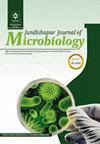中国一家非三级医院耐碳青霉烯肺炎克雷伯菌病例的分子特征和系统发育联系的基因组学研究:一项队列研究
IF 0.5
4区 医学
Q4 MICROBIOLOGY
引用次数: 0
摘要
背景:耐碳青霉烯类肺炎克雷伯菌(CRKP)菌株已被列为临床关注的主要菌株之一。目的:在本研究中,我们调查了来自非三级医院的CPKP分离株,以寻找传播性克隆并分析广泛的表型和遗传多样性。方法:在本队列研究中,2021年共收集了来自同一地区3家医院的49株CRKP分离株。分析了流行率和耐药性模式。临床数据是从电子病历系统中检索的。分析了分子类型、抗微生物耐药性(AMR)谱、质粒复制子和毒力因子。利用单核苷酸多态性(SNPs)构建了最大似然系统发育树和传播网络。结果:患者的中位年龄(N=49)为66.0岁,其中85.7%为男性。最常见的CRKP感染是医院内肺炎(75.5%),其次是菌血症(10.2%)。超过53%的分离株对头孢他啶-阿维巴坦(CAZ/AVI)具有耐药性。45个分离株成功测序;主要的碳青霉烯抗性基因是blaKPC-2(93.3%)。我们队列中的30天死亡率为24.5%。最主要的序列类型(ST)是ST11(60.0%),其次是ST15(13.3%)。全基因组测序(WGS)分析显示,ST11菌株克隆、ST420和ST15克隆在医院内外传播。结论:在本监测研究中,由于ST11是主要的流行克隆,在医院和该地区发现了CRKP的几个传播链。我们的研究结果表明,中国非三级医院需要有效的感染控制措施和抗菌药物管理。本文章由计算机程序翻译,如有差异,请以英文原文为准。
Genomic Insights Into Molecular Characteristics and Phylogenetic Linkage Between the Cases of Carbapenem-Resistant Klebsiella pneumoniae From a Non-tertiary Hospital in China: A Cohort Study
Background: Carbapenem-resistant Klebsiella pneumoniae (CRKP) strains have been listed as one of the major clinical concerns. Objectives: We investigated CPKP isolates from non-tertiary hospitals to find disseminated clones and analyze extensive phenotypic and genetic diversity in this study. Methods: In this cohort study, a total of 49 CRKP isolates from 3 hospitals in the same region were collected in 2021. The prevalence and antimicrobial susceptibility patterns were analyzed. Clinical data were retrieved from electronic medical record systems. The molecular types, antimicrobial resistance (AMR) profiles, plasmid replicons, and virulence factors were analyzed. The maximum-likelihood phylogenetic tree and transmission networks were constructed using single-nucleotide polymorphisms (SNPs). Results: The median age of patients (N = 49) was 66.0 years, and 85.7% were male. The most common CRKP infection was nosocomial pneumonia (75.5%), followed by bacteremia (10.2%). More than 53% of isolates were resistant to ceftazidime-avibactam (CAZ/AVI). Forty-five isolates were successfully sequenced; the predominant carbapenem-resistant gene was blaKPC-2 (93.3%). The 30-day mortality in our cohort was 24.5%. The most dominant sequence type (ST) was ST11 (60.0%), followed by ST15 (13.3%). Whole genome sequencing (WGS) analysis exhibited dissemination of ST11 strain clones, ST420, and ST15 clones, both within and outside the given hospital. Conclusions: In this surveillance study, several dissemination chains of CRKP were discovered in the hospital and the region, as ST11 was the main epidemic clone. Our findings suggest that effective infection control practices and antimicrobial stewardship are needed in non-tertiary hospitals in China.
求助全文
通过发布文献求助,成功后即可免费获取论文全文。
去求助
来源期刊

Jundishapur Journal of Microbiology
MICROBIOLOGY-
CiteScore
1.30
自引率
0.00%
发文量
56
审稿时长
6-12 weeks
期刊介绍:
Jundishapur Journal of Microbiology, (JJM) is the official scientific Monthly publication of Ahvaz Jundishapur University of Medical Sciences. JJM is dedicated to the publication of manuscripts on topics concerning all aspects of microbiology. The topics include medical, veterinary and environmental microbiology, molecular investigations and infectious diseases. Aspects of immunology and epidemiology of infectious diseases are also considered.
 求助内容:
求助内容: 应助结果提醒方式:
应助结果提醒方式:


